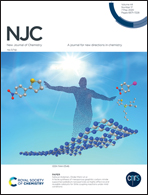Synthesis, photophysical and electrochemical properties of donor–acceptor type hydrazinyl thiazolyl coumarins†
Abstract
A water-mediated MCR strategy has been developed for the synthesis of donor (D)–acceptor(A) type hydrazinyl thiazolyl coumarins (HTCs) (4) in excellent isolated yields (90–98%) from a three component reaction of aromatic aldehydes/ketones (1), thiosemicarbazide (2) and 3-(2-bromoacetyl)-2H-chromen-2-one (3) catalyzed by an environmentally compatible montmorillonite (MMT) K10 clay at RT for 20–40 min. The present MCR strategy has several advantages that include its wide-spread substrate scope, eco-compatibility, short reaction times and products that do not require chromatographic purification. Besides, the method is simple to perform, it is easy to construct C–N, C![[double bond, length as m-dash]](https://www.rsc.org/images/entities/char_e001.gif) N and C–S bonds in one pot and the reaction can be scaled up to a gram level. Moreover, the catalyst can be reused 7 times without significant change of activity. The photophysical properties of the synthesized D–A type HTCs are also studied and it was noticed that the fluorescence properties can be varied with the position of electron donating group on the aromatic ring of aldehyde/ketone of HTCs. Most of the compounds exhibited bright fluorescence in chloroform (1.0 × 10−5 M) with emission maxima ranging from 409 to 511 nm and large Stokes shifts. Further, the HOMO and LUMO energy levels of the HTCs are found in the range from −5.65 eV to −5.22 eV and −2.67 eV to −2.17 eV, respectively, and in good agreement with the reported hole transporting materials.
N and C–S bonds in one pot and the reaction can be scaled up to a gram level. Moreover, the catalyst can be reused 7 times without significant change of activity. The photophysical properties of the synthesized D–A type HTCs are also studied and it was noticed that the fluorescence properties can be varied with the position of electron donating group on the aromatic ring of aldehyde/ketone of HTCs. Most of the compounds exhibited bright fluorescence in chloroform (1.0 × 10−5 M) with emission maxima ranging from 409 to 511 nm and large Stokes shifts. Further, the HOMO and LUMO energy levels of the HTCs are found in the range from −5.65 eV to −5.22 eV and −2.67 eV to −2.17 eV, respectively, and in good agreement with the reported hole transporting materials.



 Please wait while we load your content...
Please wait while we load your content...